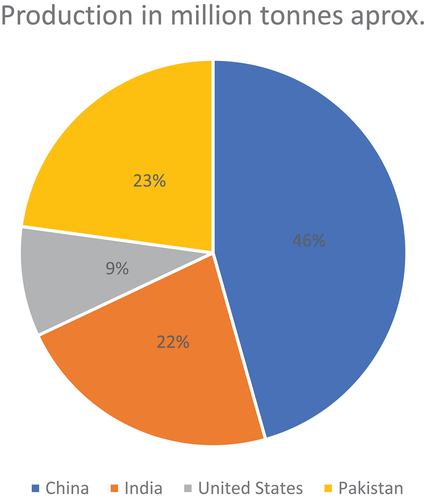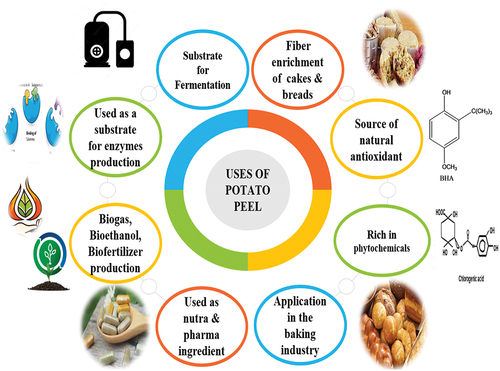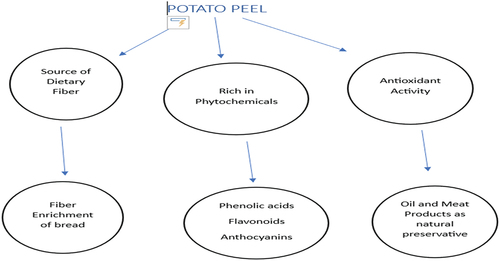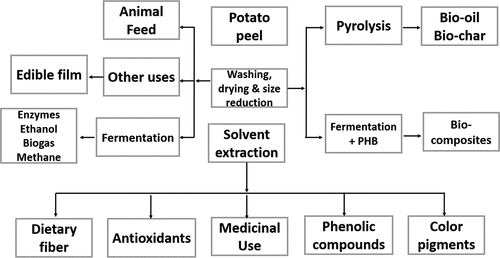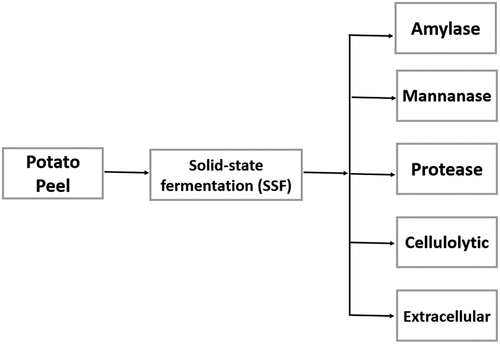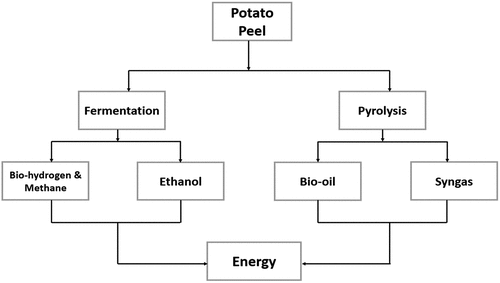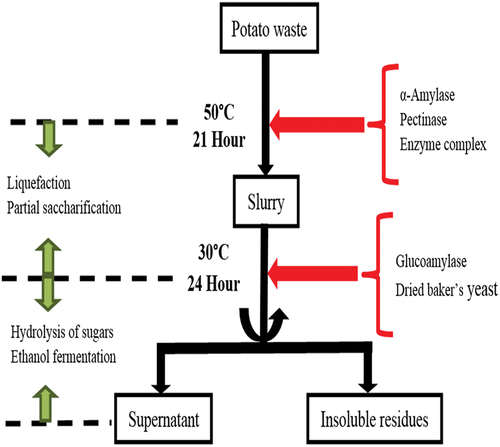ABSTRACT
Potato (Solanum tuberosum L.) is a vital agricultural commodity. It is widely cultivated and consumed in the world. The potato processing industry is emerging and generates an enormous amount of potato peel, which is considered waste. Inappropriate handling of this by-product gives rise to environmental pollution. Potato peel (PP) is an excellent resource of valuable bioactive compounds. It can potentially utilized as a food preservative, supply of dietary fiber in bakery products, pharmaceutical ingredients, animal feed, and renewable energy sources to boost eco-friendly food sectors. The potato peel powder is composed of crude fiber, moisture, ash, protein, and total lipids. However, utilization of potato peel waste can be improved economy. This review was designed to cover potato peel’s physiochemical properties and valorization. This predicts that using PP can not only shrink the waste load of the environment but also serve the pharmaceutical and food sectors considerably.
1. Introduction
Across the world, food waste is a crucial problem because approximately one billion individuals worldwide are facing malnutrition and hunger as food manufactured for human utilization is wasted or lost. Food waste is generally referred to as food that is acceptable for consumption but eventually finishes up discarded or unconsumed (Khalid et al., Citation2019). Around 89 million tons of food waste is produced in the European Union, which will probably increase 40‐fold (Kumar et al., Citation2020). In Pakistan, the condition is also similar: around 60% of the people are suffering from food insecurity, whereas 44% of the kids’ experience retorted growth due to undernourishment. Such shortcomings need prompt consideration and action for a country defaced with food insecurity and hunger (Aamir et al., Citation2018).
Potato (Solanum tuberosum L.) is an economically significant staple commodity that is most widely produced and consumed globally. It is the fourth largest food crop after wheat, rice, and maize because of its substantial contribution to human consumption (Karamova et al., Citation2023; Majeed & Muhammad, Citation2018). In underdeveloped countries like Pakistan, people can get all the nutrients they need from potatoes, which are less expensive and an excellent source of minerals, fiber, vitamin B6, vitamin C, and some trace elements (Zaheer & Akhtar, Citation2016). Currently, the overall potato sector is going through significant modifications. Previously, fresh potato utilization, which used to be the basis of potato consumption, is constantly shrinking, particularly in developing nations due to the increasing incomes and population, the demand for processed items such as chips, frozen fries, crisp, canned potatoes, and puree have elevated (Fradinho et al., Citation2020). Food manufacturing and processing is the primary sector of agriculture. In food manufacturing industries, mainly potato chips, a significant amount of potato peel cut away. Depending upon the peeling technique, the production and processing losses in potato peel waste (PPW) form can fluctuate from 15–40% (Kot et al., Citation2020). The percentage of Potato producing Countries are presented in the .
PP is a valuable source of many nutrients. Compared to potato pulp, PP comprises a higher content of several nutrients. PP contains potential bioactive compounds such as antioxidants, flavonoids, total dietary fibers, minerals, and vitamins (Jimenez-Champi et al., Citation2023; B. Singh et al., Citation2020). Potato processing generates substantial trash due to its broad application in various sectors. Potato waste, including peels, pulps, and starch, can be used in animal feed compositions (Khanal et al., Citation2023). Potato trash has the same calorie value as maize and barley but is lower in protein and calcium. Potato waste meal includes 7.6% crude protein, 7.0% ether extract, 4% crude fiber, and 4% ash and is made by drying and grinding whole potatoes, potato pulp, peelings, and discarded potato chips (Rodríguez-Martínez et al., Citation2021). Potato skin has a higher nitrogen and amino acid content than the flesh. Although the percentage of protein in potatoes is relatively low (0.7–4.6%), it may contribute to the protein intake due to the large amount consumed. Potato protein contains 18 amino acids, including the essential 9: tryptophan, leucine, isoleucine, valine, threonine, lysine, methionine, phenylalanine, and histidine (Sampaio et al., Citation2020). By tradition, low-grade fertilizer or animal feed is produced by using PPW or it can be used as raw material for biogas production, but this causes loss of rich nutrients present in the peel, which have several therapeutic characteristics such as anti-bacterial, chemopreventive, antioxidant, apoptotic and anti-inflammatory actions as represented in (Ozer Uyar & Uyar, Citation2023). Recent environmental and agricultural research emphasizes advanced methods for consuming PPW in food manufacturing, biosynthesis, and pharmaceutical industries, which enhance the value of PP waste (Wu, Citation2016). This review introduces the valorization of potato peel and proposes ideas for recycling PP. Furthermore, it investigates potato peels (PP), an underutilized resource with various uses. Despite being considered waste, PP includes functional bioactive components that could be used as a renewable energy source, nutritional fiber` for baked goods, pharmaceutical substances, animal feed, and food preservation. Potato peel powder’s nutritional composition is further supported by physiochemical research (N. Pathak et al., Citation2022; Tripathi, Diwan, et al., Citation2023). The revolutionary potential of turning this by-product into commercially viable resources is highlighted in this article, offering a long-term solution to environmental pollution while fostering economic sectors that are especially important in developing nations.
2. Composition of potato peel
It is essential to focus on the chemical and physical aspects of potato peel waste in order to comprehend its physiochemical characteristics. Understanding these characteristics would help create environment-friendly methods for applying potato peel (Javed et al., Citation2019). represents the various components found in PP.
Table 1. Chemical constituents of potato peel.
The color and composition of potatoes and peel vary according to geographical cultivation regions (P. D. Pathak et al., Citation2015). Potato peel consists of a range of nutritionally essential components such as dietary fibers, lipids, fatty acids, polyphenols, and phenolic acids exhibiting antibacterial and antioxidant activities. It can be utilized in the pharma and food industries (Tlay et al., Citation2023). It also contains minerals and vitamins, particularly vitamins B and C and iron, calcium, and phosphorous (B. Singh et al., Citation2020). Raw potato peel contains high content of carbohydrates and moisture, whereas, in general, lipids and protein contents are low. PP is a rich source of starch (52 g per 100 DW), making it a suitable base for fermentation. PPW comprised of non-starch polysaccharide 30%, starch 25%, acid insoluble and soluble lignin 20%, protein 18%, lipids 1%, and ash 6%. Lipids constitute triglycerides, long chain fatty acids, sterols, alcohol, phenolics, and esters. Cell walls of potatoes contain polyaliphatic and polyaromatic domains. Phenylpropane units made a three-dimensional structure of lignin, which is also found in the cell walls of potatoes (Kot et al., Citation2020). Different Bioactive compounds present in the potato peel are presented in the .
The increased demand for protein is driving a significant growth in the market for vegetable-based proteins. There is growing interest in proteins made from potatoes as individuals search for substitutes for other protein sources. These adaptable tubers, which were formerly disregarded due to their low protein concentration, are now acknowledged as a viable source of plant-based protein. Potato proteins are starting to compete in the dynamic market for vegetable-based proteins due to changing consumer attitudes and an increased focus on various protein options (Tripathi, Sharma, et al., Citation2023). Potatoes contain vital amino acids, for maintaining healthy muscles and overall well-being. Surprisingly potatoes offer an amount of protein, although they may not be as concentrated as meat or legumes. Including potatoes, in a diet can contribute to diversifying protein sources and enhancing nutrition (Nadalet, Citation2023).
shows the elemental analysis of potato peel. The C/N ratio of PP is 10.7 as well as the pH is 6 (Daimary et al., Citation2022). Whereas the calorific value of PP is (17.37 MJ/kg) (Sepelev & Galoburda, Citation2015).
Table 2. Elemental analysis of potato peel Liang et al. (Daimary et al., Citation2022).
A great number of polyphenols are present in potato peel. These play a vital role in the protection beside phytopathogens. Consequently, 50% of phenolic contents are found in potato peel compared to the potato’s center. PP’s oxidative nature is due to phenolic compounds’ occurrence (P. D. Pathak et al., Citation2018). The key phenolic compounds in PPW are phenolic acids mentioned in .
Table 3. Phytochemical content of Solanum tuberosum peel.
3. Valorization of potato peel
Due to its properties, PP has numerous uses and applications as illustrated in .
Valorization of potato peel into value-added products is explained in the following sections ().
Table 4. Applications of potato peel in the food industry.
3.1. Dietary fiber enrichment of bakery products
Chemical compounds, which are regarded as dietary fiber, are helpful to human wellbeing. The body’s enzymes do not digest these. The components of DF are hemicellulose, cellulose, gelatin, lignin oligosaccharides, waxes, and gums. Usually, cereals, vegetables, and soil products contain dietary strands in various sums and arrangements. Naturally different concentrations and arrangements of dietary fibers are present in vegetables, cereals, and fruits. Healthy individuals must consume around 20–35 g of total dietary fiber to maintain good health. Peel is the best source of dietary fibers (76.40% DW) (P. D. Pathak et al., Citation2018). In the production of bakery products, various dietary fiber resources have replaced wheat flour. In a study, it was revealed that waste potato peel as being better than wheat fiber in their water holding limit with less quantity of starchy part and total dietary fiber content. Loaf volume was reduced, and crumb darkening was increased when PP was added to the bread. Another study identified that the stale odor produced in bread after the incorporation of PP could be reduced by the extrusion of peel before adding. A huge impact was noticed on the physical qualities after adding PP in the biscuits. Incorporating 5% and 10% (w/w) of the peel in biscuit flour substitution base had less sensory score (appearance and color) and stack weight to the levels utilized. Furthermore, supplemented biscuits were rigid to chew as compared to control biscuits. It was explored that muffins containing 25% PP were more dark in color, low in height, and impervious to firmness. Cookies comprising PP (10% and 15%) were less in diameter, hard, and darker than the controlled cookies (Joshi et al., Citation2020). Jeddou et al. (Citation2017). combined PP flour in cake and dough as a dietary fiber and protein source. They noticed great color variation among the sample aided with peel and control samples. The combination of a peel with flour considerably also decreases the hardness of the cake alongside yellowness and lightness values. The research confirmed that fiber-supplemented cake with better quality, enhanced dough strength, and proportion of elasticity to extensibility. Curti et al. (Citation2016). mixed potato peel fiber (0.4 g fiber/100 g flour) into bread. The addition of fiber resulted in variation in the moisture content and water activity, which affected the softness of bread, whereas the staling of bread was also reduced
3.2. As a natural antioxidant
In the food business, quantity losses may appear due to lipid oxidation. The most applicable technique to overcome this problem is the addition of artificial antioxidants to processed food items to diminish the building of toxic oxidation particles and prevent rancidity, thereby increasing the shelf life of food. It is observed that the consumption of elevated concentrations of artificial antioxidants such as BHT and BHA pose serious hazards to health such as cancer. These days, the awareness to utilize natural antioxidants among consumers has increased because they are more beneficial for health and have no negative impact. PP is an ample source of antioxidants like phenolic compounds. PP holds back 10 times higher concentration of polyphenols when contrasted with potato pulp. In a study, antioxidants are extracted through a mixture of water solutions: acetone: 0.1% of HCL mixture in methanol (10:30:60 v/v/v). Total polyphenols (177 mg/100 g) were present in the PP. It was analyzed that a positive connection exists between polyphenolic components in PP extracts and antioxidant potential (Al-Weshahy & Rao, Citation2012). Gallic acid and chlorogenic acids are major phenolic compounds present in PP extracts (B. Singh et al., Citation2020). The Peel of young potato is a good resource of bioactive phytochemicals possessing great antioxidant potency (Arun et al., Citation2015). In another study by Habib, & Shah (Samotyja, Citation2019) potential of PP extract as a natural antioxidant was evaluated in soybean oil. As a result, a drop in values of peroxide (10.0, 9.0 meq/kg) and FFA (0.120, 0.109%) in samples of soybean oil were observed consisting of 2400 and 1600 ppm of petroleum ether extract from PP stored at 45°C for 60 days. As an antioxidant, PP has been consumed in various food products. Potato peel was used as a resource of natural antioxidant to increase the shelf life of biscuits by retarding the lipid oxidation (Rowayshed et al., Citation2015). After six months of storage, the biscuits containing 0.5, 1, 2, as well as 3% of potato peel extract exhibited oxidative durability in the following order: control < 2% < 1% < 0.5% < BHA (200 ppm) < potato peel extract at 3%. These results prove that different concentrations of PP extract indicated strong antioxidation activity compared to artificial antioxidants such as BHA and control. When freeze-dried PP extract was incorporated in raw beef patties helpful antioxidant results were gained over 12 days at 5°C (Munekata et al., Citation2020). PP extract has been useful to restrain the unpleasant impacts of irradiation on meat. Unfavorable oxidative changes during irradiation can be effectively restarted in meat using PP extract (Papadochristopoulos et al., Citation2021). The waste potato peel’s antioxidant property was almost like the BHT, an artificial antioxidant (Bariya et al., Citation2020). These studies prove that PP extract shows high antioxidant activity equivalent to artificial antioxidants even when added in higher quantities. Therefore, to control the lipid oxidation in fats, oils, and different food items PP extracts can be securely consumed as natural antioxidants. As compared to artificial preservatives PP waste extracts as an antioxidant is non-mutagenic and non-carcinogenic (Sepelev & Galoburda, Citation2015).
3.3. Antimicrobial activity
Sulfur compounds i.e. allylsulphide and allicin, are present in garlic and onion for their application in processed food items as natural antimicrobials. Similarly, PP extracts exhibited antimicrobial activity due to terpenes and flavonoids (Al-Kayali et al., Citation2021). Amanpour (Amanpour et al., Citation2015) also reported that waste PP extract is nontoxic in food manufacturing industries as it has non-mutagenic bacteriostatic action.
3.4. In edible film
Waste potato peel can also use to produce edible films. Kang and Min (Kang & Min, Citation2010) prepared edible film from soy lecithin and glycerol. The film developed under high-pressure homogenization at 138 MPa presented good color properties, and tensile and moisture barrier.
3.5. Medicinal application of potato peel
Potato peel can be utilized as wound healing and anti-ulcer agent as is a good source of starch. This amazing characteristic of potato peel allows it to be used as bandages in medicine. Initially, potato peels are washed in clean saline water and afterward applied on burns by setting the inward surface of the peel toward the wound. The peels are set side-by-side and safeguarded with two bandages and saline gauze layers. The benefits of utilizing bandages of potato peel are the following: (I) faster recovery of skin to normal texture and color, (II) quick epithelial recovery, (III) Less painful removal of the bandage and (IV) Comfort. One of the extra advantages of these bandages is that they do not shrink during the entire period of application (P. D. Pathak et al., Citation2018). In contrast with gauze bandages, potato peel bandages decrease or remove dryness, which in result recovers skin cells and helps in quick renewal of epithelial. These bandages can be a good option for healing burn wounds because of their cheap production cost and simple application (N. Singh et al., Citation2008). Potato peel has solid antioxidant characteristics. The peel extracts offset CCl4-initiated liver injury and they likewise display a defensive impact against oxidative pressure and diabetes in rodents. PP has solid cancer prevention agent properties. The PP extricates altogether offset CCl4-initiated liver injury and likewise display a defensive impact against oxidative pressure and diabetes in rodents (Khosravi et al., Citation2019). Due to these qualities, PP can be utilized constituent in the well-being of human health and functional foods
3.6. Animal feed
In the past few years, several studies have proven that vegetable and fruit waste produced from processing can be efficiently utilized in livestock feed production to achieve nutritious and good quality animal feed. Potato peel is a great source of polyphenols therefore it can be utilized in animal feed production (Kasapidou et al., Citation2015). In recent years, livestock feedlot operators and farmers have fed cows with PP. Milk production and meat quality can be improved to some extent by feeding PP. In sheep feed, PP can effectively exchange up to 50% of concentrate feed mix consisting of wheat bran (35%), yellow corn (30%), cottonseed meal (25%), rice bran (4%), molasses (3%), sodium chloride (1%) and mineral & vitamins (0.5%) (Tawila et al., Citation2008). For fish, PP is also considered a good feed. After consuming PP for 30 days, improvements were seen in the protein and fat characteristics of the muscles and liver tissues. PP has no negative effects and is beneficial to fish and ruminant health (Abootalebi et al., Citation2020).
3.7. Enzyme production
Another very useful application of potato peel is the synthesis of enzymes. It can be used as a substrate in solid-state fermentation for the growth of microbes (Kot et al., Citation2020). summarizes the enzymes synthesized using potato peel waste (P. D. Pathak et al., Citation2018). Starch content (52 g/100 g DW) makes potato peel an excellent base for fermentation (Kot et al., Citation2020). Mannanases have many applications in different industrial processes such as reducing the viscosity of extracts in producing vegetable oil and coffee. Among several lignocellulosic substances like rice husk, corn cob, mango, apple, citrus, and wheat straw: PP was considered the most favorable medium for producing mannanase by Bacillus amyloliquefaciens. During the process, the peel acted as a source of carbon (14 g/L optimized dose) maximum mannanase activity (105.7 U/mg protein) was obtained (Vijayaraghavan et al., Citation2019). Amylases have major application in textile, detergent, baking, and food sectors in addition it is also used in the saccharification or liquefaction of starch. Amylases are synthesized by Aspergillus niger, Bacillus licheniformis, and Bacillus subtilis grown on tuber peel. Enzyme activity by strains of Bacillus subtilis (600 U/mL) and Bacillus licheniformis (270 U/mL) was obtained, respectively (Abootalebi et al., Citation2020). Proteases are used as an additive in the detergent industry. In general, the cost of production is reduced when SSF produces proteases as this process does not need extra supplementation for nitrogen and carbon (Vijayaraghavan et al., Citation2019). Extracellular enzymes such as polygalacturonate lyase and a-amylase whereas cellulolytic enzymes like xylanase, cellulose, and cellulase can also be synthesized using Bacillus subtilis and Aspergillus niger through SSF of potato peel (Dos Santos et al., Citation2012).
3.8. Production of energy from potato peel waste
Because petroleum-based fuels fluctuate in price, future oil sources will run out, and governments are restricting CO2 emissions, interest in alternative fuels is growing daily. As alternatives to petroleum-based fuels, biofuels, including biodiesel, methanol, and ethanol, are gaining popularity (Izmirlioglu & Demirci, Citation2015). demonstrates the diverse pathways for the generation of energy from PPW.
3.8.1. Synthesis of bioethanol from PPW
Ethanol manufacturing can employ leftover potato peel as a substitute carbon source. Pretreatment procedures specifically, liquefaction and scarification processes are essential to converting starch of potatoes into fermentable sugars before ethanol fermentation (Izmirlioglu & Demirci, Citation2015). Enzymatic hydrolysis of starchy feedstock is accomplished in two steps. First, at high temperatures (80–110°C), amylases hydrolyze the −1,4 bonds in starch to produce maltose and maltodextrins. This is known as liquefaction (Morais et al., Citation2019). The second stage is the saccharification by glucoamylase of partly hydrolyzed starch. A pure glucose stream is generated. Glucose is fermented into ethanol by Saccharomyces cerevisiae yeasts, as shown in (Khawla et al., Citation2014).
3.8.2. Biogas production from PPW
Waste potato peel has a significant potential to be utilized as a basis of environmentally friendly power such as biogas (Adeyosoye et al., Citation2014). Bio-gas creation capacity of potato peel by mesophilic anaerobic bacteria was surveyed by Gebrechristos and Chen (Citation2018). For this purpose, a bioreactor with an environment-friendly method of waste use can produce bio-fertilizer, power, and great quality of biogas, contingent on the limit of the bioreactor and measure of bio-waste, and so on. It has been accounted that every huge amount of starch waste produces 250 m3 of biogas. In another review, the capability of the anaerobically processed peel of potato and its buildup of lactic acid was explored to produce methane. The analytical outcomes uncovered methane production up to 60 to 70%. The digester involving waste potato peel fermentation deposits as feedstock showed the greatest combined methane production of 273 Liter/kg with great execution, trailed by 239 Liter/kg creation by utilizing PP waste in similar circumstances (Kot et al., Citation2020). Due to the presence of many insoluble constituents such as proteins, cellulose, pectin, starch, and ashes, PP biodegradability is lower. Thermal treatment via autoclaving builds the bioavailability of organic particles. This process upgrades the yield of methane and biogas, in contrast to mechanical processing pretreatment alone (Santos et al., Citation2013).
3.8.3. Bio-oil
Bio-oil is another type of fuel that can be utilized for power and heat production or as an intermediate for developing different chemicals and fuels for transport. Bio-oil is acquired by pyrolysis of biomass substances. Syngas and biochar are other products produced because of pyrolysis (Daimary et al., Citation2022). Pyrolysis of PP brings about a reduced production of bio-oil and better return of biochar. Significant measures of hydrocarbon compounds in bio-oil got from the lipids along with suberin of PP were identified, whose structure and the amount were like aliphatic mixtures in transport fuels. Besides, aromatic compounds were likewise generated from PP, which can be moved up to biofuels (Ozer Uyar & Uyar, Citation2023).
3.8.4. Bio hydrogen
As an energy resource hydrogen gas likewise acquired consideration as its consumption produces a lot of energy for each unit of weight. The burning of hydrogen discharges ecologically friendly gases when contrasted with the petrol sources, which produce greenhouse gases in the climate. Recently, the creation of bio-hydrogen gas by utilizing rural waste and microorganisms has brought more consideration (Hossain et al., Citation2014). Despite microbes, the mixture of photo fermentation followed by sequential dark fermentation brings about more creation of biohydrogen gas through the PPW when contrasted with some other fermentation processes (Richelle et al., Citation2015). Consider a waste potato peel biorefinery as an inventive and ecological way to put leftover potato peels to use. This concept calls for a thorough biorefining procedure to be applied to the peels, frequently seen as waste (P. D. Pathak et al., Citation2018). Imagine cutting-edge technologies removing valuable elements from the peels, such as proteins, fibres, and carbohydrates, and using those components to create a variety of goods, including biofuels, nutritional supplements, and biodegradable packaging (Almeida et al., Citation2023). This innovative biorefinery contributes to a more ecologically responsible and circular approach in the food business by reducing waste and turning potato peels into a helpful resource.
3.9. LCA considerations
Life Cycle Assessment (LCA) is a comprehensive method used to evaluate the environmental impacts associated with the entire life cycle of a product, process, or activity. When applied to potato peels, an often-overlooked by-product of the potato industry, LCA considerations become crucial for understanding the sustainability implications of various scenarios involving the management and utilization of these peels.
3.9.1. Agricultural stage
The life cycle of potato peels begins with the cultivation of potatoes. LCA considers the environmental impact of agricultural practices, including land use, water consumption, and using fertilizers and pesticides. Sustainable farming practices can significantly reduce the negative environmental footprint associated with the production of potatoes and their peels (Djomo et al., Citation2008).
3.9.2. Processing and harvesting
As potatoes are harvested and processed, energy consumption and water use during these stages are key LCA considerations. Efficient processing methods and technologies powered by renewable energy sources can minimize the carbon footprint associated with turning potatoes into consumer products and generating peels as byproducts(Wu, Citation2016).
3.9.3. Transportation
Once separated from the potatoes, potato peels often need to be transported for further processing or disposal. LCA evaluates the energy and emissions associated with this transportation, highlighting the importance of optimizing logistics to minimize environmental impact. Localized processing facilities or innovative waste management strategies can contribute to reducing transportation-related emissions (Almeida et al., Citation2023).
3.9.4. Biorefinery and utilization
One sustainable approach to managing potato peels is the establishment of biorefineries. LCA is pivotal in assessing the environmental benefits of converting potato peels into valuable products. Extracting fibers, starch, and proteins through advanced biorefining processes can significantly reduce the environmental impact of traditional waste disposal methods. This approach addresses waste management and contributes to the creation of renewable and biodegradable products (P. D. Pathak et al., Citation2018).
3.9.5. Product development
LCA extends to the production of goods derived from potato peels. For example, if the peels are utilized to create biodegradable packaging or biofuels, the life cycle analysis considers the environmental impact of the entire manufacturing process. This includes extracting materials from potato peels, producing end products, and any associated waste generated during manufacturing (Marzocchella et al., Citation2022).
3.9.6. End-of-life considerations
Whether the potato peels are used in biodegradable products or disposed of through other means, LCA includes an assessment of the environmental impact at the end of their life cycle. Biodegradable products from potato peels may reduce landfill waste and minimize long-term environmental impact compared to non-biodegradable alternatives (Gebrechristos & Chen, Citation2018).
For an economic boost in developing countries, proper utilization of agricultural wastes must effectively maintain elevated economic expansion and decrease poverty. In this regard, potato peel waste can be utilized for the synthesis of numerous compounds such as lactic acid, bio-sorbent, biohydrogen, enzymes, `biogas and biofertilizers which serve as a base for developing linkages among industry and sharing new ideas, technologies and future trails for sustainable economic growth. The potato peel, a zero-value material of potato processing industries, is augmented daily with the ever-escalating consumption of processed potato products. However, it is concluded that the utilization of potato peel waste is the same as converting iron into gold, boosting the economic sector for developing countries. So, research should be geared toward antimicrobial, antioxidant, and other pharmaceutical ingredients from potato processing industries. Attention has been given on low‐cost extraction method, and further investigation should also be vested on innovative products from similar by‐products.
4. Conclusion
Potato peel is one of the foremost agricultural wastes in the food manufacturing sector. Using peel can decrease the burden of waste on the climate and serve the pharmaceutical and food businesses. Many compounds are obtained using different techniques, which can be used to synthesize many valuable items. Potato peel is an excellent source of antioxidants due to its great phenolic content therefore it is gaining popularity in nutrition and dietary fiber. The higher content of starch provides a fermentation pathway that offers numerous industrial enzymes, bio fertilizers, and biofuels which serve as a promising energy resource. Nevertheless, adhered starch and high moisture are the main restrictions in handling and storing PP. Hence drying is necessary before further utilization to avoid microbial spoilage. In industries, the issue of greater expense still exists, therefore future effects should be made to lower the cost of all these methods and drive the advanced development of PPW into the application.
Acknowledgment
The authors are thankful to the University of Lahore to provide the access of free full-length papers.
Disclosure statement
No potential conflict of interest was reported by the author(s).
References
- Aamir, M., Ahmad, H., Javaid, Q., & Hasan, S. M. (2018). Waste not, want not: A case study on food waste in restaurants of Lahore, Pakistan. Journal of Food Products Marketing, 24(5), 591–10. https://doi.org/10.1080/10454446.2018.1472695
- Abootalebi, S. N., Saeed, A., Gholami, A., Mohkam, M., Kazemi, A., Nezafat, N., Mousavi, S. M., Hashemi, S. A., & Shorafa, E. (2020). Screening, characterization and production of thermostable alpha-amylase produced by a novel thermophilic bacillus megaterium isolated from pediatric intensive care unit. Journal of Environmental Treatment Techniques, 8(3), 952–960.
- Adeyosoye, O. I., Adesokan, I. A., Afolabi, K. D., & Ekeocha, A. H. (2014). Estimation of proximate composition and biogas production from in vitro gas fermentation of sweet potato (Ipomea batatas) and wild cocoyam (Colocasia esculenta) peels. African Journal of Environmental Science and Technology, 4(6), 388–391.
- Al-Kayali, R., Jalab, J., Kitaz, A., & Abdelwahed, W. (2021). Evaluation of antibacterial activity of some medicinal plants by bioautography. Universal Journal of Pharmaceutical Research, 6(4), 42–49. https://doi.org/10.22270/ujpr.v6i4.639
- Almeida, P. V., Gando-Ferreira, L. M., & Quina, M. J. (2023). Biorefinery perspective for industrial potato peel management: Technology readiness level and economic assessment. Journal of Environmental Chemical Engineering, 11(3), 110049. https://doi.org/10.1016/j.jece.2023.110049
- Al-Weshahy, A., & Rao, V. A. (2012). Potato peel as a source of important phytochemical antioxidant nutraceuticals and their role in human health-A review. IntechOpen.
- Amanpour, R., Abbasi-Maleki, S., Neyriz-Naghadehi, M., & Asadi-Samani, M. (2015). Antibacterial effects of Solanum tuberosum peel ethanol extract in vitro. Journal of Herbal Medicine Pharmacology, 4(2), 45–48.
- Arun, K. B., Chandran, J., Dhanya, R., Krishna, P., Jayamurthy, P., & Nisha, P. (2015). A comparative evaluation of antioxidant and antidiabetic potential of peel from young and matured potato. Food Bioscience, 9, 36–46. https://doi.org/10.1016/j.fbio.2014.10.003
- Bariya, A. R., Patel, A. S., & Joshi, A. B. (2020). Application of natural antioxidants from vegetables, plant and fruits origin into meat and meat products-A review. Journal of Meat Science and Technology| January-March, 8(1), 12–22.
- Curti, E., Carini, E., Diantom, A., & Vittadini, E. (2016). The use of potato fibre to improve bread physico-chemical properties during storage. Food Chemistry, 195, 64–70. https://doi.org/10.1016/j.foodchem.2015.03.092
- Daimary, N., Eldiehy, K. S., Boruah, P., Deka, D., Bora, U., & Kakati, B. K. (2022, February). Potato peels as a sustainable source for biochar, bio-oil and a green heterogeneous catalyst for biodiesel production. Journal of Environmental Chemical Engineering, 10(1), 1–10. https://doi.org/10.1016/j.jece.2021.107108
- Djomo, S. N., Humbert, S., & Blumberga, D. (2008). Life cycle assessment of hydrogen produced from potato steam peels. International Journal of Hydrogen Energy, 33(12), 3067–3072. https://doi.org/10.1016/j.ijhydene.2008.02.006
- Dos Santos, T. C., Gomes, D. P. P., Bonomo, R. C. F., & Franco, M. (2012). Optimisation of solid state fermentation of potato peel for the production of cellulolytic enzymes. Food Chemistry, 133(4), 1299–1304. https://doi.org/10.1016/j.foodchem.2011.11.115
- Fradinho, P., Oliveira, A., Domínguez, H., Torres, M. D., Sousa, I., & Raymundo, A. J. (2020, July). Improving the nutritional performance of gluten-free pasta with potato peel autohydrolysis extract. Innovative Food Science & Emerging Technologies, 63(1), 1–9. https://doi.org/10.1016/j.ifset.2020.102374
- Gebrechristos, H. Y., & Chen, W. (2018). Utilization of potato peel as eco‐friendly products: A review. Food Science & Nutrition, 6(6), 1352–1356. https://doi.org/10.1002/fsn3.691
- Hossain, M. B., Tiwari, B. K., Gangopadhyay, N., O’Donnell, C. P., Brunton, N. P., & Rai, D. K. (2014). Ultrasonic extraction of steroidal alkaloids from potato peel waste. Ultrasonics Sonochemistry, 21(4), 1470–1476. https://doi.org/10.1016/j.ultsonch.2014.01.023
- Izmirlioglu, G., & Demirci, A. (2015). Enhanced bio-ethanol production from industrial potato waste by statistical medium optimization. International Journal of Molecular Sciences, 16(10), 24490–24505. https://doi.org/10.3390/ijms161024490
- Javed, A., Ahmad, A., Tahir, A., Shabbir, U., Nouman, M., & Hameed, A. (2019). Potato peel waste-its nutraceutical, industrial and biotechnological applacations. AIMS Agriculture and Food, 4(3), 807–823. https://doi.org/10.3934/agrfood.2019.3.807
- Jeddou, K. B., Bouaziz, F., Zouari-Ellouzi, S., Chaari, F., Ellouz-Chaabouni, S., Ellouz-Ghorbel, R., & Nouri-Ellouz, O. (2017). Improvement of texture and sensory properties of cakes by addition of potato peel powder with high level of dietary fiber and protein. Food Chemistry, 217, 668–677. https://doi.org/10.1016/j.foodchem.2016.08.081
- Jimenez-Champi, D., Romero-Orejon, F. L., Moran-Reyes, A., Muñoz, A. M., & Ramos-Escudero, F. (2023). Bioactive compounds in potato peels, extraction methods, and their applications in the food industry: A review. CyTA-Journal of Food, 21(1), 418–432. https://doi.org/10.1080/19476337.2023.2213746
- Joshi, A., Sethi, S., Arora, B., Azizi, A. F., & Thippeswamy, B. (2020) Potato peel composition and utilization. In P. Raigond, B. Singh, S. Dutt, & S. K. Chakrabarti (Eds.), Potato (pp. 229–245). Springer.
- Kang, H. J., & Min, S. C. (2010). Potato peel-based biopolymer film development using high-pressure homogenization, irradiation, and ultrasound. LWT-Food Science Technology, 43(6), 903–909. https://doi.org/10.1016/j.lwt.2010.01.025
- Karamova, N., Tuama, A. A., & Stasevski, Z. (2023). Endophytic microorganisms of potato (Solanum tuberosum L.): Biodiversity, functions and biotechnological potential. Ecological Genetics, 21(2), 123–135. https://doi.org/10.17816/ecogen196737
- Kasapidou, E., Sossidou, E., & Mitlianga, P. (2015). Fruit and vegetable co-products as functional feed ingredients in farm animal nutrition for improved product quality. Agriculture, 5(4), 1020–1034. https://doi.org/10.3390/agriculture5041020
- Khalid, S., Naseer, A., Shahid, M., Shah, G. M., Ullah, M. I., Waqar, A., Abbas, T., Imran, M., & Rehman, F. (2019). Assessment of nutritional loss with food waste and factors governing this waste at household level in Pakistan. Journal of Cleaner Production, 206, 1015–1024. https://doi.org/10.1016/j.jclepro.2018.09.138
- Khanal, S., Karimi, K., Majumdar, S., Kumar, V., Verma, R., Bhatia, S. K., Kumar, V., Kuca, K., Esteban, J., & Kumar, D. (2023). Sustainable utilization and valorization of potato waste: State of the art, challenges, and perspectives. Biomass Conversion and Biorefinery, 1–26. https://doi.org/10.1007/s13399-023-04521-1
- Khawla, B. J., Sameh, M., Imen, G., Donyes, F., Dhouha, G., Raoudha, E. G., & Oumèma, N. E. (2014). Potato peel as feedstock for bioethanol production: A comparison of acidic and enzymatic hydrolysis. Industrial Crops and Products, 52(1), 144–149. https://doi.org/10.1016/j.indcrop.2013.10.025
- Khosravi, Z., Sedaghat, R., Baluchnejadmojarad, T., & Roghani, M. (2019, May 1). Diosgenin ameliorates testicular damage in streptozotocin-diabetic rats through attenuation of apoptosis, oxidative stress, and inflammation. International Immunopharmacology, 70, 37–46. https://doi.org/10.1016/j.intimp.2019.01.047
- Kot, A. M., Pobiega, K., Piwowarek, K., Kieliszek, M., Błażejak, S., Gniewosz, M., & Lipińska, E. (2020, September). Biotechnological methods of management and utilization of potato industry waste—a review. Potato Research, 63(1), 431–447. https://doi.org/10.1007/s11540-019-09449-6
- Kumar, H., Bhardwaj, K., Sharma, R., Nepovimova, E., Kuča, K., Dhanjal, D. S., & Kumar, D. (2020). Fruit and vegetable peels: Utilization of high value horticultural waste in novel industrial applications. Mole, 25(12), 2812. https://doi.org/10.3390/molecules25122812
- Majeed, A., & Muhammad, Z. (2018). Potato production in Pakistan: Challenges and prospective management strategies–a review. Pakistan Journal of Botany, 50(5), 2077–2084.
- Marzocchella, A., Chirone, R., Paulillo, A., Lettieri, P., & Salatino, P. (2022). Sustainability assessment of biotechnological processes: LCA and LCC of second-generation biobutanol production. In C. Teodosiu, S. Fiore, & A. Hospido (Eds.), Assessing progress towards sustainability (pp. 365–382). Elsevier.
- Morais, R. R., Pascoal, A. M., Pereira-Júnior, M. A., Batista, K. A., Rodriguez, A. G., & Fernandes, K. F. (2019, September). Bioethanol production from Solanum lycocarpum starch: A sustainable non-food energy source for biofuels. Renewable Energy, 140(1), 361–366. https://doi.org/10.1016/j.renene.2019.02.056
- Munekata, P. E., Gullón, B., Pateiro, M., Tomasevic, I., Domínguez, R., & Lorenzo, J. M. (2020, September). Natural antioxidants from seeds and their application in meat products. Antioxidants, 9(9), 8–15. https://doi.org/10.3390/antiox9090815
- Nadalet, C. (2023). Influences of vegan status on protein intake, strength, and bone mineral density [ Doctoral dissertation, Arizona State University].
- Ozer Uyar, G. E., & Uyar, B. (2023, October). Potato peel waste fermentation by Rhizopus oryzae to produce lactic acid and ethanol. Food Science and Nutrition, 11(10), 5908–5917. https://doi.org/10.1002/fsn3.3670
- Papadochristopoulos, A., Kerry, J. P., Fegan, N., Burgess, C. M., & Duffy, G. (2021, July). Natural anti-microbials for enhanced microbial safety and shelf-life of processed packaged meat. Foods, 10(7), 1–8. https://doi.org/10.3390/foods10071598
- Pathak, P. D., Mandavgane, S. A., & Kulkarni, B. D. (2015). Fruit peel waste as a novel low-cost bio adsorbent. Reviews in Chemical Engineering, 31(4), 361–381. https://doi.org/10.1515/revce-2014-0041
- Pathak, P. D., Mandavgane, S. A., Puranik, N. M., Jambhulkar, S. J., & Kulkarni, B. D. (2018). Valorization of potato peel: A biorefinery approach. Critical Reviews in Biotechnology, 38(2), 218–230. https://doi.org/10.1080/07388551.2017.1331337
- Pathak, N., Singh, S., Singh, P., Singh, P. K., Singh, R., Bala, S., Thirumalesh, B. V., Gaur, R., & Tripathi, M. (2022). Valorization of jackfruit waste into value added products and their potential applications. Frontiers in Nutrition, 9, 1061098. https://doi.org/10.3389/fnut.2022.1061098
- Richelle, A., Ben Tahar, I., Hassouna, M., & Bogaerts, P. (2015). Macroscopic modelling of bioethanol production from potato peel wastes in batch cultures supplemented with inorganic nitrogen. Bioprocess and Biosystems Engineering, 38(9), 1819–1833. https://doi.org/10.1007/s00449-015-1423-6
- Rodríguez-Martínez, B., Gullón, B., & Yáñez, R. (2021, October). Identification and recovery of valuable bioactive compounds from potato peels: A comprehensive review. Antioxidants, 10(10), 1–10. https://doi.org/10.3390/antiox10101630
- Rowayshed, G., Sharaf, A. M., El-Faham, S. Y., Ashour, M., & Zaky, A. A. (2015). Utilization of potato peels extract as source of phytochemicals in biscuits. Journal of Basic and Applied Research, 8(3), 190–201.
- Samotyja, U. (2019, December). Potato peel as a sustainable resource of natural antioxidants for the food industry. Potato Research, 62(4), 435–451. https://doi.org/10.1007/s11540-019-9419-2
- Sampaio, S. L., Petropoulos, S. A., Alexopoulos, A., Heleno, S. A., Santos-Buelga, C., Barros, L., & Ferreira, I. C. (2020, September). Potato peels as sources of functional compounds for the food industry: A review. Trends in Food Science & Technology, 103(4), 118–129. https://doi.org/10.1016/j.tifs.2020.07.015
- Santos, S., Azeitona, D., Lapa, N., Morais, J., Lopes, H., & Mendes, B. (2013). Study on the effect of thermal pre-treatments in the thermophilic anaerobic digestion of a potato peel waste. In International Anaerobic Digestion Symposium within the BioGasWorld, Berlin.
- Sepelev, I., & Galoburda, R. (2015). Industrial potato peel waste application in food production: A review. Research for Rural Development, 1,(5) 130–136.
- Singh, N., Kamath, V., Narasimhamurthy, K., & Rajini, P. S. (2008). Protective effect of potato peel extract against carbon tetrachloride-induced liver injury in rats. Environmental Toxicology and Pharmacology, 26(2), 241–246. https://doi.org/10.1016/j.etap.2008.05.006
- Singh, B., Singh, J., Singh, J. P., Kaur, A., & Singh, N. (2020, June). Phenolic compounds in potato (Solanum tuberosum L.) peel and their health‐promoting activities. International Journal of Food Science & Technology, 55(6), 73–81. https://doi.org/10.1111/ijfs.14361
- Tawila, M. A., Omer, H. A. A., & Gad, S. M. (2008). Partial replacing of concentrate feed mixture by potato processing waste in sheep rations. Cellulose, 20(2.50), 26–73.
- Tlay, R. H., Abdul-Abbas, S. J., El-Maksoud, A. А. А., Altemimi, A. B., & Abedelmaksoud, T. G. (2023). Functional biscuits enriched with potato peel powder: Physical, chemical, rheological, and antioxidants properties. Food Systems, 6(1), 53–63. https://doi.org/10.21323/2618-9771-2023-6-1-53-63
- Tripathi, M., Diwan, D., Shukla, A. C., Gaffey, J., Pathak, N., Dashora, K., Pandey, A., Sharma, M., Guleria, S., Varjani, S., Nguyen, Q. D., & Gupta, V. K. (2023). Valorization of dragon fruit waste to value-added bioproducts and formulations: A review. Critical Reviews in Biotechnology, 1–19. https://doi.org/10.1080/07388551.2023.2254930
- Tripathi, M., Sharma, M., Bala, S., Connell, J., Newbold, J. R., Rees, R. M., Aminabhavi, T. M., Thakur, V. K., & Gupta, V. K. (2023). Conversion technologies for valorization of hemp lignocellulosic biomass for potential biorefinery applications. Separation and Purification Technology, 320, 124018. https://doi.org/10.1016/j.seppur.2023.124018
- Vijayaraghavan, P., Arasu, M. V., Rajan, R. A., & Al-Dhabi, N. A. (2019, February). Enhanced production of fibrinolytic enzyme by a new Xanthomonas oryzae IND3 using low-cost culture medium by response surface methodology. Saudi Journal of Biological Sciences, 26(2), 217–224. https://doi.org/10.1016/j.sjbs.2018.08.029
- Wu, D. (2016). Recycle technology for potato peel waste processing: A review. Procedia Environmental Sciences, 31, 103–107. https://doi.org/10.1016/j.proenv.2016.02.014
- Zaheer, K., & Akhtar, M. H. (2016). Potato production, usage, and nutrition—a review. Critical Reviews in Food Science and Nutrition, 56(5), 711–721. https://doi.org/10.1080/10408398.2012.724479

